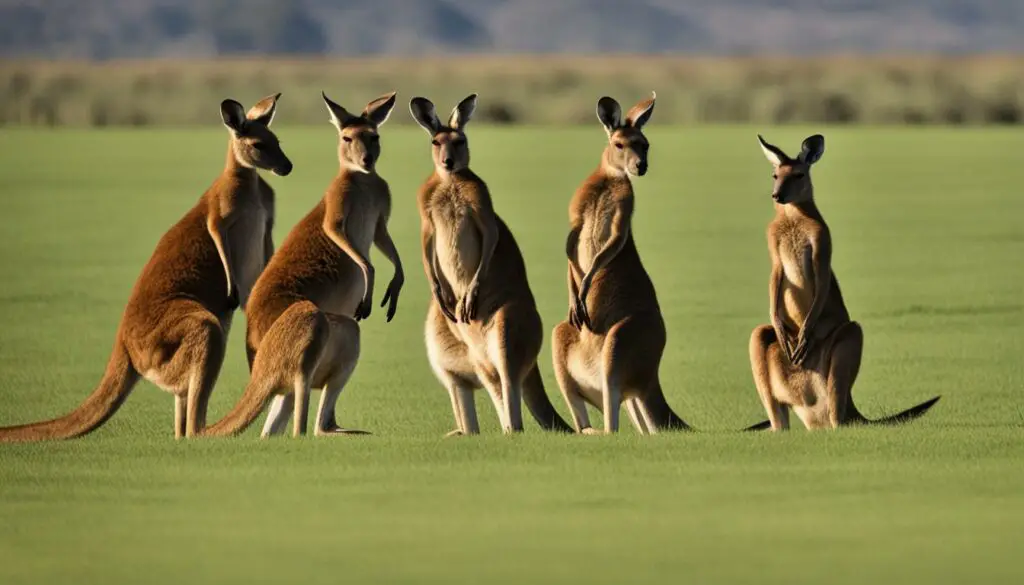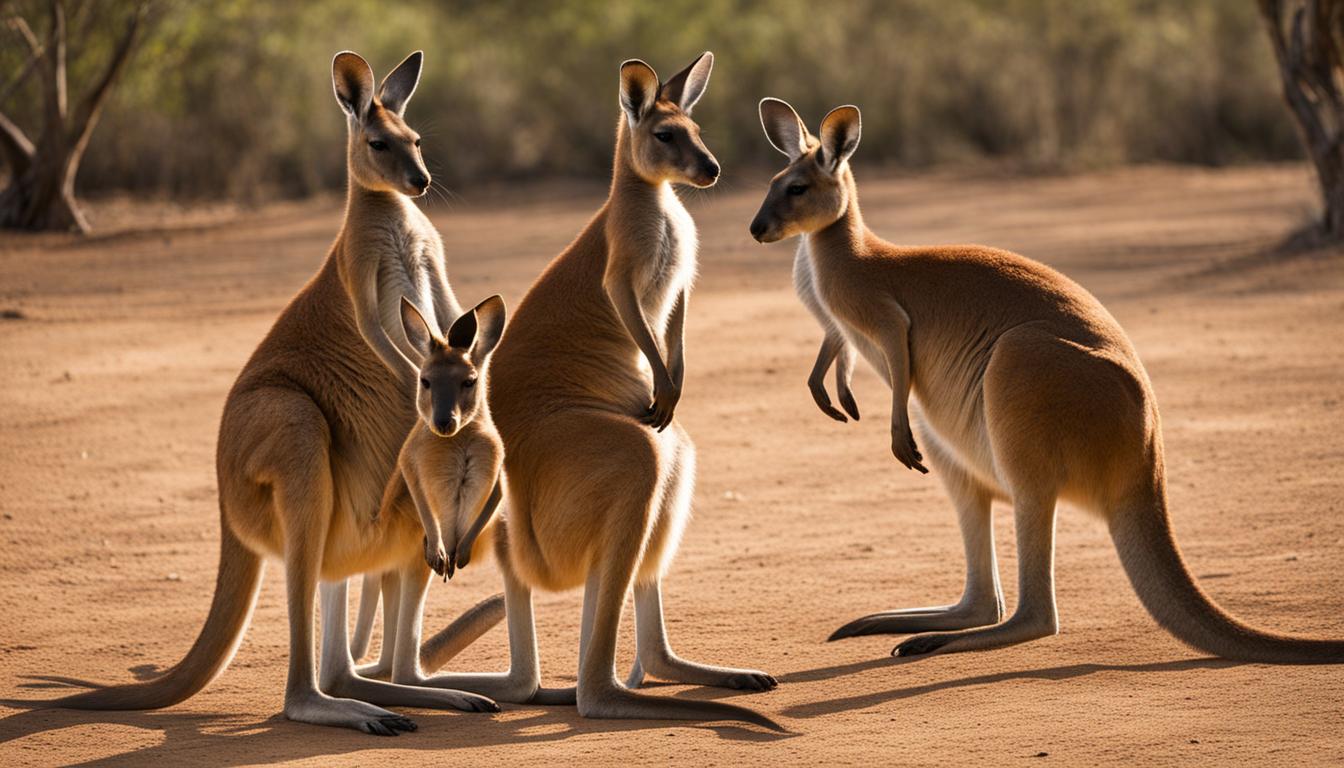Kangaroos have a complex social structure that is established through a ranking system within their groups. This social hierarchy determines the dominance and status of each individual kangaroo within the group. The hierarchy is influenced by factors such as age, sex, and reproductive status, and is crucial for understanding how kangaroos interact and maintain social cohesion within their groups.
Kangaroo Group Dynamics
Within a kangaroo group, dominance plays a significant role in establishing the social order. Dominant kangaroos have higher status and access to resources, such as food and mates. Dominance is typically determined through physical contests, known as boxing, where male kangaroos fight for dominance over females. The dominant male leads the group and has exclusive mating rights. Female kangaroos also establish a dominance hierarchy, which influences their social interactions and access to resources. Group dynamics are maintained through various behaviors, like scent marking and vocalizations, that help reinforce social bonds and establish individual roles within the group.
Kangaroo group dynamics can be observed through their social interactions and behaviors. Scent marking is an important communication method used by kangaroos to establish and maintain their social order. By marking their territories with their unique scent, kangaroos can assert dominance and territorial ownership. Vocalizations, such as grunts and growls, also play a role in social interactions within the group, conveying dominance and signaling intent. These behaviors help establish a clear hierarchy within the kangaroo group and maintain order.
| Social Behaviors | Role |
|---|---|
| Scent Marking | Establishing dominance and territorial ownership |
| Vocalizations | Conveying dominance and signaling intent |
| Boxing | Males fighting for dominance over females |
In addition to physical behaviors, kangaroos also exhibit social behaviors like grooming and social play. These behaviors help strengthen social bonds and maintain social cohesion within the group. Grooming serves as a form of social bonding and communication, while social play allows kangaroos to establish and practice social roles within the group. Through these behaviors, kangaroos develop and maintain relationships, contributing to the overall stability and function of the group.
Kangaroo Social Behavior
Kangaroos are fascinating creatures known for their unique social behavior and organization within their groups. They engage in a variety of social interactions that help strengthen social bonds and maintain group cohesion. Understanding their social behavior provides valuable insights into their ecology and adaptation.
One key aspect of kangaroo social behavior is the formation of close bonds within their groups. They engage in grooming, nose touching, and social play, which help establish and strengthen social relationships. These behaviors not only promote social cohesion but also contribute to the overall well-being of individual kangaroos. By forming strong social bonds, kangaroos gain social support, protection, and increased chances of survival.
Kangaroos also communicate through visual and olfactory signals. Scent marking, vocalizations, and body postures play important roles in their social interactions. These communication methods help establish dominance and social order within the group. For example, dominant individuals may use scent marking to assert their dominance and establish their territory. Vocalizations, such as grunts and growls, are used to communicate warnings or aggressive intentions.
To provide a deeper understanding of kangaroo social behavior, Table 1 presents a comparison of key behaviors observed in different kangaroo species. This comparative analysis highlights the variations in social structure and behavior, shedding light on the complexities of kangaroo society.
| Kangaroo Species | Social Behavior |
|---|---|
| Red Kangaroo | Large groups with a dominant male, females establish their hierarchy |
| Eastern Grey Kangaroo | Smaller groups with a dominant male, females have a linear hierarchy |
| Western Grey Kangaroo | Smaller groups with a dominant male, females compete for higher rank |
In summary, kangaroo social behavior is characterized by the formation of close bonds, social play, and a complex communication system. These behaviors contribute to the establishment of a social order and play a crucial role in the overall well-being and survival of kangaroo groups.
Kangaroo Reproduction and Social Organization
Kangaroos exhibit fascinating reproductive behavior and have a unique social organization that revolves around their breeding patterns. Understanding these aspects is crucial to gaining insight into the dynamics of kangaroo groups and their overall social structure.
Kangaroo social organization is strongly influenced by reproductive behavior. Female kangaroos have the remarkable ability to delay giving birth until conditions are favorable. This delayed implantation allows them to conserve resources and ensure the survival of their offspring. It is a remarkable adaptation that ensures the young kangaroos have the best chance of survival in their demanding environment.
Female kangaroos have a unique reproductive system where they can delay giving birth until environmental conditions are more favorable. This allows them to conserve resources and ensure the survival of their offspring.
On the other hand, male kangaroos play a crucial role in the social organization of the group through their reproductive behavior. Males compete for mates through dominance displays and physical fights. The dominant male establishes his place in the social hierarchy and has exclusive mating rights within the group. By ensuring the survival of his genes, the dominant male contributes to the overall genetic diversity of the group.
Kangaroo Breeding Seasons
Kangaroo breeding seasons vary based on factors such as climate, food availability, and overall environmental conditions. The timing of breeding seasons ensures that young kangaroos are born during periods when resources are abundant, increasing their chances of survival. These breeding seasons also play a role in shaping the social dynamics within kangaroo groups, as males compete for mates and establish their dominance during these periods of heightened reproductive activity.
Overall, the reproductive behavior of kangaroos is intricately linked to their social organization. The ability of females to delay giving birth and the competition among males for mating rights contribute to the establishment and maintenance of the social hierarchy within kangaroo groups. Understanding these reproductive behaviors provides valuable insights into the complex social dynamics and adaptability of these iconic Australian marsupials.
| Key Reproductive Behaviors | Role in Social Organization |
|---|---|
| Delayed Implantation in Females | Allows females to conserve resources and ensure offspring survival |
| Dominance Displays and Fighting among Males | Establishes social hierarchy and exclusive mating rights for dominant males |
| Breeding Seasons | Influences social dynamics and competition for mates |
The Benefits of Kangaroo Social Organization
Kangaroo groups have a complex social structure that provides several benefits to both the individual kangaroos and the group as a whole. Understanding these benefits can shed light on the importance of the kangaroo social hierarchy and their overall well-being.
One of the key benefits of the social organization in kangaroos is the maintenance of social stability within the group. The dominance hierarchy helps reduce conflicts by establishing clear roles and responsibilities for each individual. This allows for efficient resource distribution, ensuring that dominant individuals have priority access to food and mates. By reducing competition and establishing a social order, kangaroo groups can function harmoniously and minimize unnecessary aggression.
“The dominance hierarchy helps reduce conflicts by establishing clear roles and responsibilities for each individual.”
Another significant benefit of the kangaroo social structure is the formation of social bonds and increased chances of survival. Within the group, individuals form close relationships through social interactions like grooming, nose touching, and social play. These social bonds provide kangaroos with social support and protection. Additionally, being part of a group increases the overall vigilance against predators, as there are more individuals to collectively detect and respond to potential threats.
Furthermore, the social organization of kangaroos allows for the transfer of knowledge and skills between generations. Older, more experienced individuals can pass on valuable information about food sources, migration routes, and other important survival strategies. This transmission of knowledge ensures the group’s adaptability and helps them thrive in their environment.
Table: Benefits of Kangaroo Social Organization
| Benefits | Description |
|---|---|
| Reduced conflicts | The dominance hierarchy establishes clear roles, reducing unnecessary aggression and maintaining social stability within the group. |
| Social support and protection | Close social bonds provide individuals with support, increasing their chances of survival and protection against predators. |
| Knowledge transfer | Older, experienced individuals pass on valuable information and survival strategies to younger generations, ensuring group adaptability. |
Overall, the social organization in kangaroos offers numerous benefits, including reduced conflicts, increased social support, and the transmission of knowledge. These benefits contribute to the well-being and success of kangaroo groups, allowing them to thrive in their natural habitat.
Kangaroo Social Flexibility and Adaptability
Kangaroos exhibit remarkable social flexibility and adaptability, allowing them to thrive in various environmental conditions. Their loose social structure and ability to adjust their social behaviors make them highly adaptable to changing circumstances.
One of the ways kangaroos demonstrate their social flexibility is through the formation and dissolution of social bonds. These bonds can change over time as individuals interact and build new relationships within the group. This adaptability enables kangaroos to adjust to fluctuations in food availability, reproductive cycles, and group dynamics.
Their social flexibility also extends to their hierarchical structure. While dominance plays a crucial role in establishing the social order within kangaroo groups, individuals can shift positions within the hierarchy based on their age, reproductive status, and physical condition. This adaptability allows for a more dynamic and responsive social structure within the group.
Overall, the social flexibility and adaptability of kangaroos contribute to their success as a species. By being able to adjust their social behaviors and hierarchy, kangaroos can effectively navigate varying environmental conditions and maintain social cohesion within their groups.

The Role of Social Flexibility in Survival
In addition to enhancing their ability to respond to environmental changes, social flexibility plays a vital role in the survival of kangaroo groups. By forming and dissolving social bonds, kangaroos can establish new alliances and expand their social network. This allows for greater cooperation and increased chances of finding necessary resources, such as food and water.
The Evolution of Kangaroo Sociality
Kangaroos, like many other animal species, have evolved complex social structures over time. The development of social behavior in kangaroos has been driven by various factors, such as the need for protection, resource sharing, and successful reproduction. By studying the evolution of kangaroo sociality, researchers gain valuable insights into the development of social behavior in other species as well.
One of the key factors influencing the evolution of kangaroo sociality is the advantage of group living. Group living provides kangaroos with increased protection against predators and a better chance of survival in harsh environments. Within these groups, kangaroos establish social hierarchies that help maintain social order and reduce conflicts. The dominance hierarchy ensures efficient resource distribution, with dominant individuals having priority access to food and mates.
Researchers have observed that the social behavior and organization of kangaroos have evolved to maximize the reproductive success of dominant males. The dominant male, with exclusive mating rights, ensures the survival of his genes within the group. This evolutionary adaptation has contributed to the establishment and maintenance of social structures in kangaroo groups.
Kangaroo sociality is not static but rather flexible and adaptable to changing environmental conditions. Kangaroos can adjust their social behaviors and hierarchy in response to factors such as food availability and reproductive cycles. This flexibility allows for the formation and dissolution of social bonds within kangaroo groups, ensuring their survival and success in various habitats.
| Benefits of Kangaroo Sociality | Evolutionary Insights |
|---|---|
| Enhanced protection against predators | Understanding the development of social behavior in other species |
| Efficient resource distribution | Insights into the advantages of group living |
| Increased reproductive success | Contributions of dominant males to the survival of their genes |
| Social support and cohesion | Flexibility and adaptability in response to environmental changes |
The evolutionary journey of kangaroo sociality showcases the remarkable ways in which animals adapt to their environments and optimize their chances of survival. By continuing to study and learn from these fascinating marsupials, researchers can deepen their understanding of the factors that shape social behavior in a wide range of species.
Conclusion
To summarize, kangaroos have a complex social hierarchy that is established through various behaviors and influenced by factors like age, sex, and reproductive status. The dominance hierarchy within kangaroo groups plays a vital role in maintaining social order, resource distribution, and group cohesion.
Kangaroos engage in a range of social behaviors, including grooming, nose touching, and social play, to establish and strengthen social bonds within their groups. These behaviors, along with visual and olfactory communication, help reinforce the social structure and establish individual roles within the group.
Understanding the social organization and behavior of kangaroos is crucial for understanding their ecology, adaptation, and overall well-being. Further research into kangaroo sociality will continue to unveil the fascinating dynamics of these iconic Australian marsupials.
Does the Dominance Hierarchy in Kangaroo Groups Impact Their Feeding Behavior?
Yes, the dominance hierarchy in kangaroo groups has a significant impact on their kangaroo diet and feeding habits. The dominant kangaroos have priority access to food and can displace subordinate individuals. This can lead to differences in feeding patterns and behavior among members of the group.
FAQ
How are social hierarchies established in kangaroo groups?
Kangaroo social hierarchies are established through a ranking system within their groups. This hierarchy is determined by factors such as age, sex, and reproductive status, and is established through behaviors like fighting and display.
What are kangaroo group dynamics?
Kangaroo group dynamics involve dominance hierarchies that determine social order and resource access. Dominant kangaroos have higher status and exclusive mating rights, while social behaviors such as scent marking and vocalizations help maintain group cohesion.
What social behaviors do kangaroos exhibit?
Kangaroos engage in social behaviors such as grooming, nose touching, and social play. These behaviors help strengthen social relationships, establish bonds, and reinforce their social structure within the group.
How does kangaroo reproduction relate to their social organization?
Kangaroo reproduction plays a crucial role in their social organization. Female kangaroos have the ability to delay giving birth until environmental conditions are more favorable, allowing them to conserve resources. Males compete for mates through displays of dominance, establishing their place in the social hierarchy.
What are the benefits of kangaroo social organization?
Kangaroo social organization provides benefits such as social stability, efficient resource distribution, social support, protection, and increased chances of survival.
Are kangaroos socially flexible and adaptable?
Kangaroos exhibit a high level of social flexibility and adaptability. They can adjust their social behaviors and hierarchy to changing environmental conditions, ensuring their survival and success.
How has kangaroo sociality evolved?
Kangaroo social behavior and organization have evolved over time. Group living and social hierarchy became advantageous for increased protection, resource sharing, and reproductive success.
What are the key takeaway points about kangaroo sociality?
Kangaroo social hierarchy, dynamics, behavior, and reproduction are all interconnected and play essential roles in their ecological adaptation and overall well-being. Further research into kangaroo sociality will continue to unveil fascinating insights about these iconic Australian marsupials.











